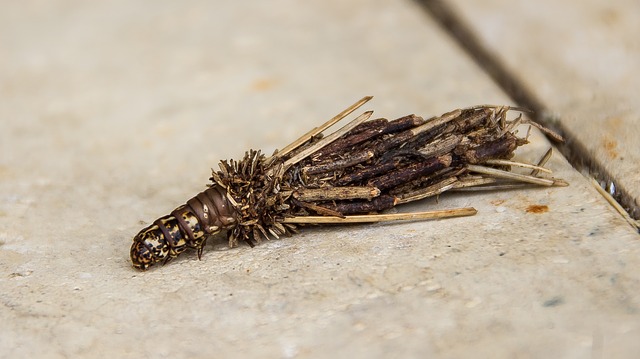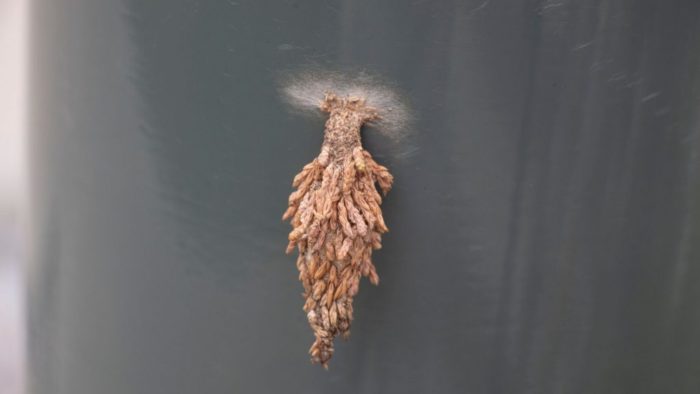Many homeowners have been confused with these strange pests hanging on their walls and ceilings.
They are shaped like watermelon seeds and have gray and flat elongated bodies. And, sometimes, you’ll even see a worm’s head sticking out of their encasements!
So, what are these strange pests? Well, they are called plaster bagworms!
Don’ be fooled by their odd appearance! These pests can cause structural damage to your homes.
As such, in this article, we will let you in on some pro tips in getting rid of these bagworms in no time.
These tips will save you tons of stress and worry in dealing with these nuisance-hanging pests. Read more of these pro tips listed below.
What Are Plaster Bagworm?

If you’ve seen a strange pest in your walls or ceilings that looks like a grey watermelon seed, then that is a plaster bagworm.
These pests are called plaster bagworms not because they love to eat plaster, but instead, they are commonly found hanging on plaster walls and ceilings.
Hence, they are named ‘plaster bagworms.’ If you have a light-colored wall, you’ll easily spot these hanging pests.
Inside your homes, they are attached to the bottom side of the furniture or along the edges of your rugs.
Basically, plaster bagworms are caterpillars who always carry their bag around. Plaster bagworms are giant moths encased in a silk bag or blanket.
Thus, these strange pests are enclosed in a protective ‘silk bag.’ Females lay their eggs in the bottom of the walls or crevices.
Within a week, a single female can lay up to 200 eggs! After that, she immediately dies.
Female plaster bagworms are more significant than their male counterparts. The adult female moths are gray and have a wingspan of one-half inch long.
Oftentimes, adult moths are short-lived because most of them do not eat.
And, you’ll likely find these pests inside your homes because they are drawn to high humidity and available food sources for their survival.
Things that Attract Plaster Bagworm
As we have mentioned before, plaster bagworms require necessities for their survival. Just like us, they need available food, shelter, and water.
Their diet mainly consists of spider webs, dead insects, or dead bugs.
You may be confused why these insects attached themselves to walls and ceilings, and, yes, there’s a reason behind that. Plaster bagworms love to feast on spider webs.
This is why they are stuck on walls and ceilings to be nearer to cobwebs.
Another thing is that these strange pests love high humidity. Inside your homes, there is suitable humidity needed for their survival.
It is a perfect environment for them to grow and even lay their eggs. As such, it is highly advisable to use dehumidifiers inside your homes to get rid of these plaster bagworms.
Should I Be Scared of Plaster Bagworms?
Plaster bagworms do not bite, sting, or harm humans. But, this doesn’t mean that you’ll ignore their presence.
These pests can cause damage to your walls, ceilings, and stucco. You might have noticed that if bagworms grow extensively inside your homes, there are structural damages everywhere.
Even some types of plaster bagworms eat rugs, fabric, and upholstery located inside your homes.
As such, you should not leave plaster bagworms freely hanging inside your homes. They may not be able to hurt you, but they can cause havoc inside your homes.
Over time, plaster bagworms become moths, and they can fly inside your homes and cause further damage.
Pro Tips in Getting Rid of Plaster Bagworms
Getting rid of plaster bagworms at an early stage is essential to prevent further damage inside your homes.
These pests might not be able to hurt you, but they can cause structural damage that you will indeed stress about.
As such, these are some of the pro tips you can employ in getting rid of plaster bagworms inside your homes.
Pro-Tip #1: Vacuum Thoroughly

Sanitation is a critical factor in controlling these pests inside your homes. Vacuuming spider webs will make a big difference as these pests love to feast on spider webs.
Simply, your vacuum cleaner is your best friend against these pests. It is recommended to use a vacuum with a powerful suction so that all of the bagworms are instantly rid of.
Vacuuming is one of the easiest and quickest ways to reduce the number of these pests. Remember, female bagworms lay a hundred eggs per week.
By thorough vacuuming, you lessen the chances of mating and laying eggs from these pests. Ensure to empty your vacuum in a trash bin or a dumpster right after cleaning.
Pro-Tip #2: Clean Unkempt Areas
Plaster bagworms are not picky eaters. These pests love to feast on a variety of organic materials.
It is not strange that these pests eat wool, fabric, and spider webs as part of their diet.
If you left your garage or basement unkempt and cluttered, then it is highly likely that bagworms would love to infest those areas.
So, you’ll want to focus on areas within your house that need to be cleared right away. Also, bagworms consume spider webs primarily found in your garage or basement.
As such, deep cleaning of unkempt places inside your homes is critical in getting rid of these bagworms at a moment’s notice.
Pro-Tip #3: Dim or Reduce Outside Lights
Plaster bagworms are the larvae of moths. Later on, these pests will turn into adult moths. One thing that attracts these pests is outdoor lights.
If you have bright lights on your patio every night, these can attract bagworms. If possible, turn off or dim your outside lights. This will lessen the number of bagworms drawn inside your homes.
If you must have outdoor lights, just change the bulbs to yellow ones. Yellow bulbs are known not to attract moths or even bagworms.
Also, it is recommended to cover up your windows with curtains as the lights coming in from the inside may further draw bagworms into your domain.
Pro-Tip #4: Use a Dehumidifier
Bagworms thrive when there is high humidity. And, where else can they enjoy humid air? Well, it is inside your home.
It is no wonder that bagworms hang in your walls and ceilings as they thrive on humid air inside your homes.
Increased use of air conditioners and a dehumidifier will likely reduce the number of bagworms living under your roofs.
Remember, just keep your home cool and dry. This will also lessen the number of spiders living inside your homes.
And in turn, bagworms have no reason to also migrate inside your house.
By lowering the humidity of your homes, you make the environment least favorable for bagworms to even survive.
Pro-Tip #5: Repel the Presence of Spiders
As mentioned before, plaster bagworms love to consume on abandoned webs left hanging inside your homes.
Just reduce the growing population of spiders in your homes, and you’ll have fewer webs to deal with.
It’s like a chain reaction: if there is a lesser presence of spiders or insects inside your homes, then bagworms are also reduced in number.
It is recommended to use essential oils, vinegar, or Windex in repelling the spiders or insects inside your homes.
These are the least-toxic alternatives you can try at home, and they will not risk the health of the other members of your household.
Pro-Tip #6: Call a Professional Pest Control Team
If you think that there are too many plaster bagworms inside your homes, hiring a professional pest control team is highly advisable.
The companies you choose should get rid of bagworms and apply necessary measures to control their population. If you want to get your money’s worth, make sure that you consult credible professional pest control services.
But, it doesn’t mean that you’ll easily be swayed by signing a contract that requires additional cost of services. You can ask to guarantee that these bagworms are rid of them effectively.
Final Thoughts
Plaster bagworms can cause damage to your walls, ceilings, and even furniture. They may not bite or sting you, but they can certainly cause structural damage.
As such, employing pro tips in getting rid of these nuisance strange pests is necessary. So, save yourself from stress and follow those pro tips we have shared with you.
This time, you are better equipped to handle the presence of plaster bagworms inside your homes.
Remember, deep cleaning and sanitation are your best options in getting rid of plaster bagworms. Just do these diligently, and you’ll repel these bagworms in no time.
Thanks for reading!